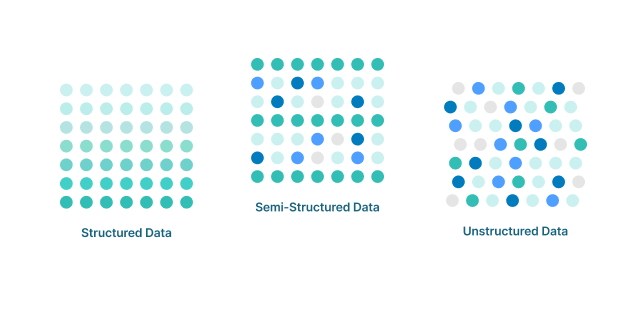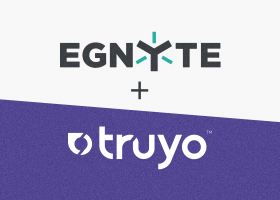Structured vs Unstructured Data
Structured vs. unstructured data is a comparison of apples and oranges—both are fruit, but very different types. Structured data is highly organized and easily accessible, because it fits a predefined model or format. Unstructured data has no set format and is not organized according to a predefined data model or manner. Classifications of structured vs. unstructured data are generally delineated based on quantitative (structured data) and qualitative (unstructured data).

There are numerous considerations associated with an evaluation of structured vs. unstructured data. Structured and unstructured data are created, collected, stored, and used in different ways with different tools.
By volume, unstructured data weighs in higher in a measurement of structured vs. unstructured data. However, assessing the pluses and minuses of structured vs. unstructured data is really a matter of use cases and the total value of the data rather than solely based on its volume.
What Is Structured Data?
Structured data is information generated by people and machines that is formatted and transformed into a well-defined data model. This data comes in numbers and letters that are easily stored in the rows and columns of tables, a format that is indicative of the predefined data model. Usually stored in a relational database (RDBMS), structured data is readily available and readable by people, applications, and machines.
Examples of structured data are:
- Addresses
- Census records (e.g., birthdate and birthplace, income, employment, gender)
- Contacts
- Credit card numbers
- Economic data (e.g., Gross Domestic Product (GDP), Annual Consumer Price Index (CPI), Inflation, Population)
- Employee records
- Geolocation information
- Library catalogs (e.g., date, author, subject, location)
- Meta-data (e.g., time and date of creation, file size, author, classification)
- Phone numbers
- Zip Codes
Structured data that humans create when interacting with computers includes:
- Medical device data
- Point of sale (POS) data
- Sensor data (e.g., Radio Frequency Identification, Global Positioning System)
- Weblog data
Human-generated structured data includes:
- Click-stream data
- Data that is input into applications (e.g., accounting apps, spreadsheets)
- Gaming data
- Online forms
Use cases for structured data include:
- Accounting
- Automated teller machine (ATM) activity
- Contacts
- Customer relationship management (CRM)
- Inventory tracking and control
- Online booking (e.g., hotels, airlines, events, restaurant reservations)
- Sales transactions
What Is Unstructured Data?
Unstructured data is information in a raw form without defined formatting or organization, although it may have a native, internal structure. Unstructured data is either processed to create a defined structure or stored in its raw, native format.
Since it lacks formatting, it is impossible to process unstructured data using tools that are designed for structured data. Instead, specialized tools are used to make it easier and more effective to collect, use, manage, store, and secure.
Unstructured data is commonly referred to as Big Data because of the volume and velocity of production associated with it. The importance of unstructured data is rapidly increasing as Big Data tools continue to expand and evolve, supporting faster processing and advanced analytics across structured and unstructured data. This has amplified the value of unstructured data as it can be used to gain new insights.
Machine-generated unstructured data includes:
- Log files
- Satellite imagery
- Sensor data (e.g., seismic, weather, ocean, factory machines)
- Surveillance photos and videos
Human-generated unstructured data includes:
- Audio files
- Chat
- Collaboration software content
- Instant messages
- Phone recordings
- Photos
- Open-ended survey responses
- Office application data (e.g., documents, presentations)
- Social media posts and comments
- Text messages
- Web pages
- Videos
Use cases for unstructured data include:
- Data mining (e.g., consumer behavior, product sentiment, purchasing patterns)
- Chatbots (i.e., performing text analysis to route customer questions to the appropriate answer sources)
- Predictive data analysis
- Root-cause analysis
Structured vs. Unstructured Data
There are many pros and cons of structured vs. unstructured data. Overall, the benefits of structured data are related to ease of use and access, while the challenges are related to limited data flexibility. The benefits of unstructured data are related to format, speed, and storage, while its limitations are related to expertise and available resources.
A few of the commonly considered pros and cons of structured vs. unstructured data are as follows:
Pros of Structured vs. Unstructured Data
Advantages of structured data
- Easily used by machine learning (ML) algorithms, because its structure simplifies and expedites manipulation and queries
- Readily accessible and interpretable by non-technical users, because it does not require an in-depth understanding of data types and manipulation tools
- More tools are available, because it has been in use for a long time
Advantages of unstructured data
- Data collections are stored in their native format, undefined until processed for use
- File formats in the database are increased
- The data pool available to data scientists is expanded
- Data scientists can prepare and analyze only the data they need
- Data can be collected quickly and easily, because it does not need to be predefined to be stored
- Data lake storage can be used, which supports high volumes of information and easy accessibility
Cons of Structured vs. Unstructured Data
Disadvantages of structured data
- Use and flexibility are limited to the intended purpose, because of the predefined structure used to collect and store it
- Changes to data require a significant expenditure of time and resources
- Storage options are limited, because it is held in systems with rigid schemas (e.g., data warehouses)
Disadvantages of unstructured data
- Data science expertise is required to prepare and analyze it, because of its undefined, non-formatted nature
- Cybersecurity protection can be more challenging, because it is often results in content sprawl
- Inaccessible to non-technical users until it has been processed, analyzed, and reports produced
- Product choices are limited, because specialized tools are required to manipulate it
- Rapid accumulation of data can overwhelm available resources
- High volumes of data can lead to increased storage costs
- Data is of little to no value until it has been processed and analyzed
Common Characteristics Considered for Structured vs. Unstructured Data
| Characteristics of Structured Data | Characteristics of Unstructured Data | |
| Origin of structured vs. unstructured data | Human-generated Machine-Generated | Human-generated Machine-Generated |
| Forms for structured vs. unstructured data | Numbers Values Text | Native format Raw information |
| Access and analysis for structured vs. unstructured data | Easy to access Easy to analyze | Difficult to access Difficult to analyze |
| Storage for structured vs. unstructured data | Requires less storage space Relational database (RDBMS) Structured query language (SQL) database Data warehouse Spreadsheet | Requires more storage space Not Only SQL (NoSQL) database Data lake |
| Models for structured vs. unstructured data | Formatted to a set data structure before being placed in data storage (i.e., schema-on-write) Predefined data model Clearly defined | Stored in its native format and not processed until it is used (i.e., schema-on-read) No predefined data model Not clearly defined |
| Scalability for structured vs. unstructured data | Highly scalable | Difficult to scale |
| Measures for structured vs. unstructured data | Quantitative | Qualitative |
| Analysis methods for structured vs. unstructured data | Classification Clustering Regression | Data mining Natural language processing (NLP) Vector search |
Semi-Structured Data, Structured Data, and Unstructured Data
In addition to being structured and unstructured, data can also be semi-structured or partially structured. This category, between structured and unstructured data, is a type of data that has some consistent and definite characteristics, as well as some variability and inconsistency. As such, semi-structured data can include both structured and unstructured data.
Semi-structured data resides in a relational database in a tagged text format. To identify specific data characteristics and scale data into records and preset fields, organizational properties are assigned to semi-structured data, such as metadata tags and semantic markers. These make semi-structured data easier to catalog, search and analyze than unstructured data.
Several points that highlight the differences between structured vs. unstructured data vs. semi-structured data are as follows.
| Structured Data | vs. Semi-Structured Data | vs. Unstructured Data |
| Well organized | Partially organized | Not organized at all |
| Less flexible and difficult to scale | More flexible and simpler to scale | Most flexible and scalable |
| Versioning performed over tuples, rows, and tables | Versioning performed using tuples or graphs | Versioning of the dataset as a whole |
| Data concurrency used for transaction management | Transaction management adapted from the database | Neither transaction management nor data concurrency are available |

Semi-Structured Data Examples
- Alternative (Alt) text
- Binary executables
- Comma-separated values (CSV)
- Data integrated from different sources
- Delimited files
- Hypertext markup language (HTML)
- JavaScript object notation (JSON)
- Slugs
- Social posts organized by tags
- Transmission control protocol/Internet protocol packets (TCP/IP)
- Web pages
- Extensible markup language (XML)
- Zipped files
SQL vs. NoSQL
No review of structured vs. unstructured data is complete without structured query language (SQL) vs. NoSQL. These are the widely used databases for structured and unstructured data.
SQL was developed by IBM in 1974 by Donald D. Chamberlin and Raymond F. Boyce. It is a programming language commonly used to manage structured data that is organized based on a set schema. With a SQL relational database, which is easy to use, almost anyone can quickly input, search, and manipulate structured data.
NoSQL, or Not Only SQL, is a database technology that uses a non-relational and schema-less data model. These non-relational databases are used by organizations that need a system that can handle large amounts of unstructured data. Because NoSQL databases do not require a fixed schema, avoid joins, and are highly scalable, they are widely used for distributed, very large unstructured data stores.
| SQL | vs. NoSQL | |
|---|---|---|
| Query language | Structured query language (SQL) | No declarative query language |
| Schema | Predefined schema | Dynamic schema |
| Examples | Oracle, Postgres, and MS-SQL | Cassandra, Hbase Mongo, DB, Neo4j, and Redis |
| When developed | 1974 | 1998 |
| Hardware | Specialized hardware | Commoditized hardware |
| Model | ACID (i.e., Atomicity, Consistency, Isolation, and Durability) | BASE (i.e., Basically Available, Soft state, Eventually Consistent) |
Structured vs. Unstructured Data Tools
Examples of Structured Data Tools
- MySQL—mass-deployed software used for mission-critical, heavy-load production systems
- PostgreSQL—for SQL and JSON querying as well as high-tier programming languages (e.g., C/C+, Java, Python)
- OLAP—for high-speed, multidimensional data analysis from unified, centralized data stores
- SQLite—self-contained, serverless, zero-configuration, transactional relational database engine
Examples of Unstructured Data Tools
- DynamoDB—for single-digit, millisecond performance at any scale
- Hadoop clusters, NoSQL databases (e.g., MongoDB, Redis, Neo4j), Amazon Simple Storage Service (S3)—for processing, storing, and managing large volumes of unstructured data without the need for a common data model and a single database schema
- Google, Oracle, and Teradata’s data lakes to store large volumes of unstructured data
- Apache Flume, Apache Storm, and Spark to import, aggregate, and move unstructured data into Hadoop
Structured vs. Unstructured Data Analytics
For quick results, structured data wins the structured vs. unstructured data analysis race. That is because structured data fits into predefined models and formats, which makes it much faster and easier to analyze than unstructured data.
Historically, unstructured data was locked away in a system’s data storage, making it very difficult to access. In addition, the volume of unstructured data made it unwieldy for analysts to wrangle. However, unstructured data is becoming much more accessible, and analysis is getting faster and easier with the help of powerful tools.
Unlike structured data, which provides quantitative results, unstructured data analytics deliver deep insights powered by powerful technologies. Among the technologies used with unstructured data are artificial intelligence, machine learning, graphical analysis, predictive analytics, and natural language processing that leverages deep learning algorithms that use neural networks to analyze data.
With these tools, patterns, keywords, sentiment, and even the meaning and context of human speech can be extracted from unstructured data sources.
Accessibility and Analytics Drive Data Decisions
Organizations’ decisions related to creating, managing, storing, and using the various types of data are increasingly driven by the value that can be derived from the data. When considering structured vs. unstructured data, there are many use cases where it is not a choice about which to use, but rather how to use both as effectively and efficiently as possible.
The rise of big data has spawned a wide range of tools that allow organizations to blend structured, semi-structured, and unstructured data, and then utilize advanced analytics applications to mine the data for valuable insights. Structured vs. unstructured data should not be an either-or, but rather a decision based on the best format for collecting and storing the data.
Some data needs to be readily accessible by any type of user. In that case, the clear answer would be to process it into structured data. Other data cannot be gathered into an organized format due to its inherent nature. That unstructured data often does not have a predetermined purpose, but instead serves as a fertile source of information that can be used for deep analysis by data scientists.
Regardless of data type, organizations need to remember the importance of knowing what data is being collected and take steps to protect sensitive data. The amount of data that organizations generate and collect can be overwhelming. However, there are solutions available to help organizations discover and access all data in order to meet stringent requirements for privacy protections and other data governance requirements.
Egnyte has experts ready to answer your questions. For more than a decade, Egnyte has helped more than 16,000 customers with millions of customers worldwide.
Last Updated: 18th April, 2022




